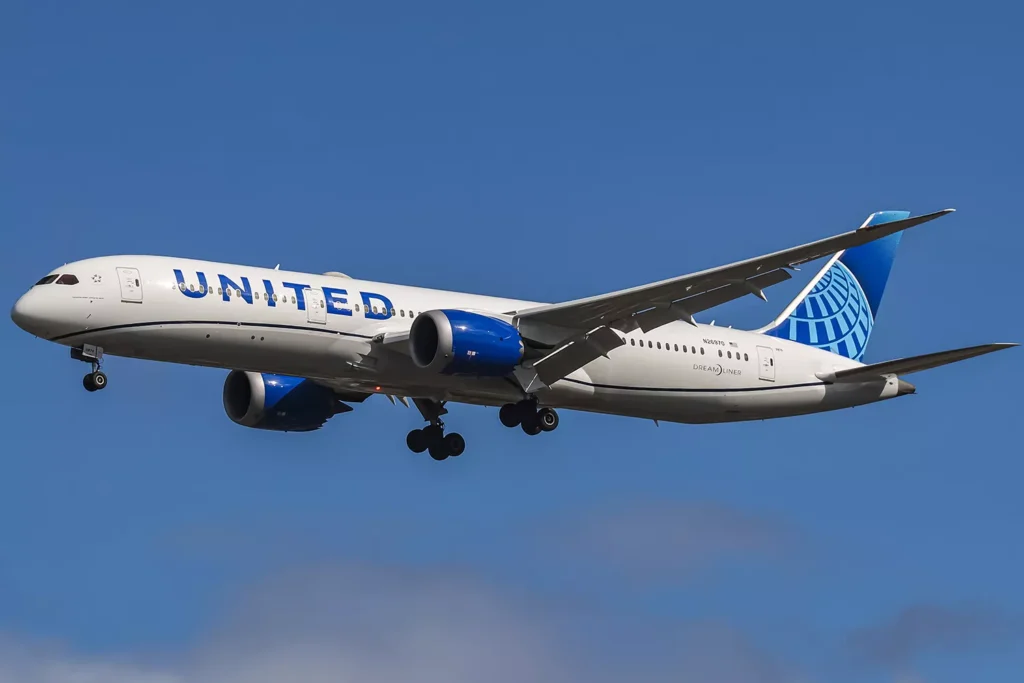A transatlantic flight turned into a tense midair emergency when United Airlines pilots were forced to declare a chilling “Mayday” just minutes after takeoff from Washington Dulles International Airport — all while carrying over 200 passengers on board.
A Routine Departure Turns Into High-Altitude Drama
On Friday evening, July 25, United Airlines Flight 108 — a Boeing 787-9 Dreamliner en route to Munich — took off from Washington Dulles with 219 passengers and 11 crew members onboard. But mere moments into its climb, the pilots noticed something was seriously wrong.
According to chilling air traffic control audio, the cockpit crew radioed:
“Failure, engine failure, left engine, United 108… Declaring an emergency.”
Moments later came the unnerving triple call: “Mayday, mayday, mayday.”
Forced to Turn Around — But There Was a Catch
At the time of the distress call, the aircraft had only reached 5,000 feet — far below cruising altitude — and air traffic controllers quickly cleared the jet to turn back to Dulles. But there was a major obstacle: the aircraft was too heavy to land safely.
Since the flight was loaded with enough fuel for a full transatlantic journey, the pilots couldn’t safely touch down without first dumping excess fuel.
Circling the skies over Virginia, the crew executed a wide holding pattern while fuel was offloaded — a necessary step to reduce weight and risk upon landing.
A Tense 30 Minutes in the Sky
For more than 30 heart-pounding minutes, passengers remained in the air while the situation was stabilized. The Boeing 787 circled twice before finally receiving clearance to land.
Thankfully, at approximately 8:30 PM local time, the Dreamliner touched down safely at Dulles. Emergency responders from the Airports Authority Fire and Rescue team were standing by as a precaution.
According to airport officials, the plane was thoroughly inspected and later towed to a gate, where all passengers deplaned safely and without injury.

United Airlines Confirms ‘Mechanical Issue’
United Airlines later released a statement, confirming the emergency landing:
“United flight 108 to Munich returned to Washington Dulles shortly after takeoff to address a mechanical issue. The plane landed safely, and all passengers deplaned normally at the gate,” said a United spokesperson.
The flight was officially canceled, and the airline worked to rebook or reroute travelers to their final destinations.
A Growing Pattern of In-Flight Incidents?
The midair scare is just the latest in a string of emergency aviation incidents this summer.
Earlier in July, a Delta Airlines flight departing Los Angeles International Airport (LAX) had to turn around after one of its engines caught fire midair. That July 18 incident, captured on video by the popular YouTube channel L.A. Flights, showed flames visibly shooting from the aircraft’s left engine shortly after takeoff.
“Delta flight 446 returned to Los Angeles shortly after departure following an indication of an issue with the aircraft’s left engine,” said a Delta spokesperson.
“As nothing is more important than the safety of our customers and crew, the flight crew followed procedures and safely returned to the gate.”
The Federal Aviation Administration (FAA) has since launched an investigation into the Delta incident.
Also in July:
- American Airlines passengers were forced to evacuate a plane using emergency slides in Miami due to a landing gear fire.
- Turkish Airlines had to evacuate passengers after smoke was seen billowing from the landing gear.
What’s Causing All These Midair Emergencies?
While each incident involves different airlines and aircraft models, aviation experts point out that increased post-pandemic flight activity and aging aircraft may be playing a role. However, most commercial jets — including Boeing’s Dreamliner — undergo rigorous maintenance and safety checks.
Still, passengers are understandably on edge. With news of emergency landings, engine failures, and evacuations making headlines weekly, flyers are wondering: Is it still safe to fly?
According to FAA data, the answer remains yes.
“Despite these high-profile events, flying continues to be the safest mode of transportation,” says aviation analyst Peter Goelz, former Managing Director of the National Transportation Safety Board (NTSB).
“The Mayday procedures you’re seeing are a testament to how well-trained these pilots are and how effective aviation protocols remain.”
Passengers React: ‘Terrifying But Grateful to Be Alive’
Though United hasn’t released personal accounts from Flight 108, several passengers have taken to social media to share their fear and gratitude.
One traveler posted on X (formerly Twitter):
“We had no idea what was going on, but the crew was calm. I didn’t know we had engine failure until after we landed. Terrifying in hindsight.”
Another shared:
“The moment I heard ‘Mayday’ later on the audio gave me chills. Mad respect to the pilots and crew for keeping us safe.”

United Airlines Under the Spotlight
While this incident ended without injuries or further incident, United Airlines — like other major carriers — continues to face scrutiny over mechanical reliability and fleet maintenance as summer travel peaks.
The airline has not specified whether the issue with the Dreamliner was engine-specific or systemic, but industry insiders suggest the engine failure may involve Rolls-Royce Trent 1000 turbines, commonly used on Boeing 787 aircraft and previously flagged for durability issues.
What’s Next? FAA Will Investigate
The FAA has not yet announced a formal investigation into the July 25 incident, but it is standard procedure for regulators to assess all in-flight emergencies involving large aircraft.
Passengers can expect a follow-up on safety reviews or possible fleet inspections if the root cause of the failure is linked to a larger trend.
✈️ Your Thoughts?
Would you still feel comfortable flying long-haul after hearing this?
Sound off in the comments — and tag someone who needs to hear this.
📲 Stay tuned to The Pop Radar (TPR) for the latest breaking stories in celebrity, travel, and lifestyle — where speed meets story.














